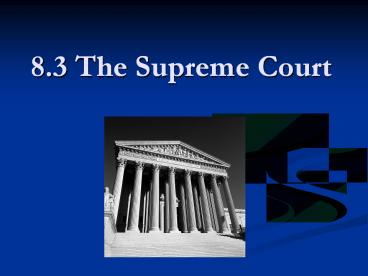8.3 The Supreme Court - PowerPoint PPT Presentation
Title:
8.3 The Supreme Court
Description:
8.3 The Supreme Court Jurisdiction The Supreme Court has original jurisdiction in only two instances: cases that involve diplomats from foreign countries and in ... – PowerPoint PPT presentation
Number of Views:493
Avg rating:3.0/5.0
Title: 8.3 The Supreme Court
1
8.3 The Supreme Court
2
Jurisdiction
- The Supreme Court has original jurisdiction in
only two instances cases that involve diplomats
from foreign countries and in disputes between
states
3
Jurisdiction
- It has final authority in any case involving the
Constitution, acts of Congress, and treaties with
other nations its decisions are binding on all
lower courts - When the Court refuses to hear a case, the
decision of the lower court stands
4
Organization and Duties
- The Supreme Court has 8 associate justices led by
a Chief Justice Congress sets this number and
has the power to change it
5
Organization and Duties
- The main duty of justices is to hear and rule on
cases they choose which to hear from among the
thousands appealed to the Court each year, then
decide the case and issue a written explanation
for the decision, called the Courts opinion
6
Selecting the Justices
- The President appoints Supreme Court justices
with approval of the Senate, vacancies open due
to resignation or death of a justice
President Obama and Sonia Sotomayor, his first
Supreme Court justice appointment
7
Selecting the Justices
- In 2005, President Bush appointed John G.
Roberts, Jr. as Chief Justice of the Supreme Court
8
Selecting the Justices
- Presidents choose nominees who are likely to be
approved, the decision is influenced by the
Attorney General and other Justice Department
officials, other Supreme Court justices, the
American Bar Association, and labor and civil
rights groups
9
Background of the Justices
- Justices are always lawyers, although it is not a
requirement, they have served as judges or held
other public positions prior to appointment
Elena Kagan served as Dean of Harvard Law
Thurgood Marshall was the NAACP lawyer in Brown
10
Background of the Justices
- The first African American justice, Thurgood
Marshall, joined the Court in 1967
11
Background of the Justices
- The first female justice, Sandra Day OConnor,
was appointed in 1981
12
Powers of the Court
- The legislative and executive branches of
government must follow the Supreme Courts
rulings it is removed from politics and the
influences of special-interest groups so the
parties involved will get a fair hearing
13
Judicial Review
- Judicial Review means the Supreme Court can
review any federal, state, or local law or action
to see if it is constitutional, or allowed by the
Constitution - If the Court decides a law is unconstitutional,
it has the power to nullify or cancel, that law
or action
14
Marbury vs. Madison
- The Constitution does not give the Supreme Court
the power of judicial review in 1803 the case of
Marbury v. Madison established that the Supreme
Court had the power to decide whether laws passed
by Congress were constitutional
15
Marbury vs. Madison
- John Marshalls opinion set forth three
principles of judicial review - The Constitution is the supreme law of the land
- If there is a conflict between the Constitution
and any other law, the Constitution rules - The Judicial Branch has a duty to uphold the
- Constitution and must be able to nullify
unconstitutional laws
16
Limits on the Supreme Court
- Under the system of checks and balances, there
are limits on the power of the federal courts,
including the Supreme Court
17
Limits on the Supreme Court
- The Court depends on the executive branch as well
as state and local officials, such as Governors
or police officers, to enforce its decisions
Orval Faubus Governor of Arkansas (Left), Little
Rock Nine (Middle), President Eisenhower (Right)
18
Limits on the Supreme Court
- Congress can get around a Court ruling by passing
a new law, or changing a law ruled
unconstitutional - Congress and state legislatures can also try to
undo Court rulings by adopting a new amendment to
the Constitution
19
Limits on the Supreme Court
- Another limit is the Court can only hear and make
rulings on cases that come to it all cases must
be an actual legal dispute, a person cannot
simply ask the Court to decide whether a law is
constitutional - The Court will not rule on a law or action that
has not been challenged on appeal and accepts
only cases that involve a federal question

